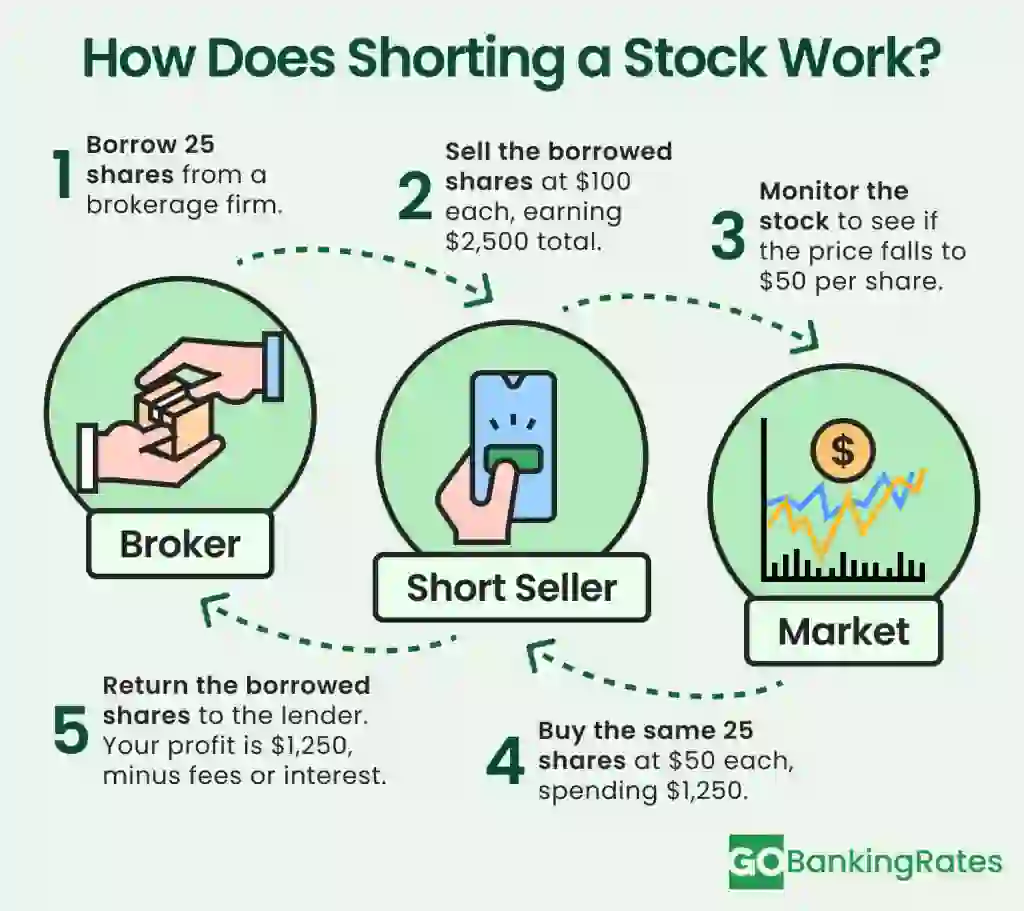What Is Short Selling? The Basics and How It Works

Commitment to Our Readers
GOBankingRates' editorial team is committed to bringing you unbiased reviews and information. We use data-driven methodologies to evaluate financial products and services - our reviews and ratings are not influenced by advertisers. You can read more about our editorial guidelines and our products and services review methodology.

20 Years
Helping You Live Richer

Reviewed
by Experts

Trusted by
Millions of Readers
Short selling is an investment technique that generates profits when shares of a stock go down rather than up. In most cases, shorting stocks is best left to the professionals. It’s mostly institutional investors, such as hedge funds, that trade this way, according to Investor’s Business Daily.
Here’s a look at how short selling works and why it’s generally not on the short list of things every new investor should know.
Before You Start Short Selling
Before you can sell a stock short, you’ll need to borrow shares to sell. You can usually accomplish this through your brokerage firm.
How Does Short Selling Work?
Here’s an overview of what it means to short a stock:
- Borrow shares: Before you can sell a stock short, you’ll need to borrow shares to sell. You can usually accomplish this through your brokerage firm.
- Sell borrowed shares: Once you’ve borrowed the stock, you sell the shares short in the open market.
- Buy back shares at a lower price: The whole objective of shorting stocks is to profit when they fall in value. If you borrowed and sold shares at $50 per share, for example, selling them when they fall to $40 in the open market will generate a gain of $10 per share.
- Return borrowed shares to lender: Once you buy back the shares on the open market, you close your position by returning them to the lender, typically through your brokerage firm.
An Example
Say you identify a stock trading for $100 per share that you think will decline in value. You borrow 25 shares and sell them for $100 each, for a total sale of $2,500. When the price drops to $50 per share, you buy 25 shares to repay the loan. The $1,250 left over, less interest due to the lender, is your profit.

What Type of Investor Should Short Sell?
Who is short selling best for? Experienced investors. When you sell a stock short, you open yourself to very little, possibly unlimited loss.
Imagine, for example, that you sell a stock short at $100 per share, thinking it will drop in price. If that stock price doubles to $200 instead, you’ll have to come up with an extra $100 per share to buy the stock back. If you shorted 100 shares, that’s $10,000. Theoretically, the stock could go to hundreds of thousands of dollars per share, in which case, you would have to cover that loss out of pocket as well.
As the long-term trend of the market is up, you’re always swimming upstream when you’re shorting stocks. To succeed, you’ll not only have to pick the right stock, you’ll also have to sell it short at the exact right time. In addition to the risk of loss if the stock rises, you’ll also be paying margin interest on the value of the shorted stock, according to Interactive Brokers. This makes research and risk management imperative when it comes to shorting stocks, something that may be beyond the abilities of beginning investors.
Pros and Cons of Short Selling
Like all financial strategies, there are pros and cons to shorting stocks. You should be aware of both before you consider getting involved.
Pros
- You can generate high profits in declining markets.
- You can hedge your position by selling them, allowing you to protect yourself from a general market decline.
- You can generate cash without having to sell any of your existing positions.
- Leverage can magnify gains.
Cons
- You court the risk of unlimited losses.
- Market volatility and momentum can push stock prices higher, even with poorly managed or underperforming companies.
- Leverage works both ways and can also magnify your losses.
- The strategy can be complex.
Risks Involved in Short Selling
While the rewards of short selling can be high, so are the risks.
Not Enough Shares To Borrow
If there aren’t enough available shares to borrow or if your broker or lender recalls those borrowed shares, then you might be forced to close your short position before you’re ready. This can limit your ability to profit, especially if the stock’s price didn’t drop as you expected. Stocks such as Joann (JOAN) or Allogene Therapeutics (ALLO) often do see low share availability.
Potential for Unlimited Losses
When you short a stock, you are on the hook to pay whatever price it rises to in the open market to buy back your borrowed shares. You could theoretically short a stock for $1 and have to buy it back for $100,000 or more, for example. This means your losses can greatly exceed your initial investment, which by definition makes short selling a risky endeavor.
Short Squeezes
This can occur when a stock that is often heavily shorted suddenly jumps up in price. You might be forced to buy those shares back at a higher price than before, which in turn, also bumps up the cost.
Dividends
If the stock earns dividends while you are holding the short position, you won’t receive those earnings. Instead, you must pay that dividend amount to the broker or lender you borrowed the shares from. This can lower the overall profit from short selling.
Market Volatility
Another reason why short selling is risky is that even if you are “right” in that a company should fundamentally trade lower, market sentiment and volatility can work against you. Probably the most famous recent example of this is the massive short squeeze that GameStop experienced in 2021.
The company itself was underperforming on a strictly financial basis, and numerous hedge funds had massive short positions. This was the birth of the so-called “meme stock” phenomenon, with numerous small investors buying up shares and forcing hedge funds to cover their positions, ultimately driving the stock up 700% in 2021. Hedge funds like Melvin Capital lost 53% in January of that year alone, according to CNBC.
SEC Regulations and Restrictions
As noted, there must be available shares to borrow before you can short a stock. If there’s no inventory or if the brokerage firm can’t locate shares, you can’t short the stock.
For institutional investors, a new law passed in 2023 now requires short sellers to publish their gross short positions to the SEC monthly. Previously, institutional short sellers had operated somewhat in the shadows, and this regulation is meant to improve market transparency.
The longstanding “uptick” rule was greatly modified in 2010. Before that, short sellers could only sell their stock on an “uptick,” or when the most recent trade took place at a higher price than the prior one. As of 2010, however, this rule only applies to stocks that have lost more than 10% in a single day, according to the SEC.
Restrictions in Other Countries
Short selling is not generally banned in other countries, but it tends to come with stringent regulations. During the 2008 financial crisis, many countries, including the U.S., temporarily banned short selling, along with the UK, Australia, Canada and many other countries. As Fortune notes, however, South Korea had a ban on short selling through March 30, 2025, with severe criminal penalties applying to any short selling during that time; this has since been reinstated.
Is It Worth The Risk?
Short selling is a high-risk, high-reward strategy. Essentially, it’s a bet that a stock will fall in price in a fairly short period, and getting that bet right can be difficult even for professional investors, especially since over time the market tends to go up, not down. The potential losses are theoretically unlimited, whereas with a long position, the most you can lose is the price you paid for your shares. Due to its risks and complexity, it’s not ideal for beginning investors.
Short Selling FAQ
Here are the answers to some of the most frequently asked questions regarding short selling.- What is the difference between short selling and buying long?
- Short selling involves borrowing shares and selling them in the hopes that their price will fall. Buying long means owning a stock and hoping that its price will increase.
- Is short selling legal in all countries?
- Short selling is legal in most countries, although many have restrictions. In the United States, for example, you can only sell a stock short on an "uptick," meaning the last trade has to be higher than the one prior to it, if a stock has fallen 10% or more in a single day. The USA, along with many other developed nations, does ban "naked" short selling, in which sellers short a stock before they have borrowed shares for the trade, according to law firm Kohn, Kohn & Colapinto.
- How much money is required for short selling?
- The margin requirement to sell a stock short is 150% of its value For example, if you want to short 100 shares of a stock trading at $200 per share, you'll need to have at least $30,000 in your account, according to Interactive Brokers. If the stock continues to trade higher, you may receive a margin call, which is a requirement to deposit additional funds.
- How to tell if a stock is being shorted?
- The percentage of a stock's shares that are being shorted is known as its short interest. This information is readily available from financial websites and from brokers like Charles Schwab, which lists each stock's short interest in its customers' accounts.
Daria Uhlig contributed to the reporting for this article.
Our in-house research team and on-site financial experts work together to create content that’s accurate, impartial, and up to date. We fact-check every single statistic, quote and fact using trusted primary resources to make sure the information we provide is correct. You can learn more about GOBankingRates’ processes and standards in our editorial policy.
- Charles Schwab. 2024. "Short Selling: The Risks and Rewards."
- Fidelity. "How to short stocks."
- Charles Schwab. 2023. "What's a Short Squeeze and Why Does It Happen?"
- Fidelity. "Using your securities to borrow money."
- Charles Schwab. 2025. "Investment Expenses: What's Tax Deductible?"
- Investor's Business Daily. 2024. "What Is A Short Squeeze And What Is Going On In GameStop, AMC."
- TD Bank. "Calculating Margins."
- Interactive Brokers. "Short Selling and Margin."
- Fortune. 2024. "Illegal short selling trades in South Korea could now get you life in prison."
 Written by
Written by  Edited by
Edited by 

























